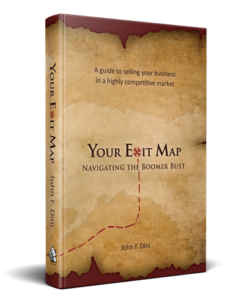(This post was published in the Sageworks/ProfitCents blog earlier this week)
Understanding the Post-Ownership Void
As advisors, we understand that our business clients should be preparing for the biggest financial event of their lives – the sale of their business. However, when we ask, “How are you exit planning for your retirement from the business?” we seldom get a straight answer.
Instead, we get any number of comments like: “I still enjoy my business, I’m not thinking about it right now.” “I have a good company. I can sell it whenever I choose.” “Everything is available for the right price. I just haven’t heard it yet.”
These are all ways of evading the fact that they haven’t thought about their life after the sale of their business, and they don’t want to. Why is having the exit planning discussion so challenging? Because, like planning one’s own funeral or purchasing life insurance, it is frightening to contemplate the end of one’s professional career.
What I Do is Who I Am
Most business owners, particularly founders, find it difficult to separate their business from their own identity. The business is who they are. At family gatherings they overhear, “There’s Bob. He owns his own business, you know.”
 The ownership of their business permeates their relationships. They are, “Bob Smith, the owner of Smith Manufacturing.” Not only in their business circles, but also at their church, in their children’s schools and their friendships. The business is their persona.
The ownership of their business permeates their relationships. They are, “Bob Smith, the owner of Smith Manufacturing.” Not only in their business circles, but also at their church, in their children’s schools and their friendships. The business is their persona.
Contemplating life after ownership is scary. Who am I if I’m not me? Will I be treated the same? Can I command the same respect if I don’t have employees? Will my opinion still matter? Will others see me as successful without the trappings of a company around me?
Some owners have the confidence to leave a business with no concern about how others will perceive them. Most, however, associate retirement on some level with failure. While owning their business, they got a small shot of adrenalin every time they were asked to make a decision, which was usually many times a day. They fear a life without those little rewards, albeit unconsciously.
Understanding this reluctance to explore the void that retirement creates is a vital part of an advisor’s ability to serve their business clients. It’s easy to say, “Okay, I’ll be here whenever you want to talk about it.” But this alone is a disservice. Planning the most important financial event of a client’s life should be a priority, not an afterthought.
Have a Safety Net
When a client avoids the exit planning question, have a safety net. Selling a business is a competitive endeavor. No smart owner would enter a new market without knowing what his competition looks like. Just because someone isn’t thinking about an exit doesn’t mean that he or she shouldn’t do anything today. Getting the conversation started is one of the most valuable services you can offer.
 Stay bonuses are so named (quite logically) because their purpose is to get key employees to stick around after a transfer of leadership. They can take a number of forms, but one of the most common is to escrow a portion of the sale proceeds for later payment if certain conditions are met.
Stay bonuses are so named (quite logically) because their purpose is to get key employees to stick around after a transfer of leadership. They can take a number of forms, but one of the most common is to escrow a portion of the sale proceeds for later payment if certain conditions are met.
 That approach helped the company grow with a balanced customer base. BVA has a presence in food testing laboratories, water and wastewater plants and the Texas oil fields, rather than the typical dominance of doctors and hospitals for their type of business.
That approach helped the company grow with a balanced customer base. BVA has a presence in food testing laboratories, water and wastewater plants and the Texas oil fields, rather than the typical dominance of doctors and hospitals for their type of business.
 For many owners, their biggest concern in an exit plan is maintaining control. Whether they seek to sell to employees, family or a third-party, there is a fear that, once started, the process will have its own rules and momentum.
For many owners, their biggest concern in an exit plan is maintaining control. Whether they seek to sell to employees, family or a third-party, there is a fear that, once started, the process will have its own rules and momentum.